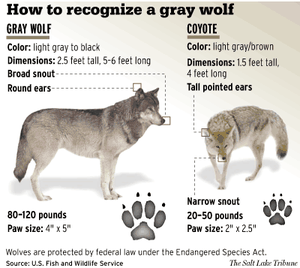Chart helps viewers distinguish wolf from coyote
WILDLIFE WATCHING -- A reader called today wondering if the animals he saw west of Spokane recently were wolves or coyotes.
He didn't have a photo to help with the identification and he didn't measure tracks, so there's no way to tell for sure.
The chart above gives some distinguishing features to note when you see canines in the field.
Here's some elaboration from Washington Department of Fish and Wildlife biologists:
One of the greatest differences between the two species is size, which can be difficult to estimate determine at a distance. A gray wolf is much larger than a coyote. Wolves weigh 80 to 120 pounds, while coyotes weigh 20 to 50 pounds. Track size measures about four by five inches for wolves, compared to two by two and a half inches for coyotes.
Ear shape is also much different; wolves have somewhat rounded ears while coyotes have taller, pointed ears. Wolves have a broader, shorter snout, while coyotes have a narrow more pointed nose. A wolf’s howl is long and drawn out, while a coyote produces a shorter, yapping sound. Fur coloration can be quite similar between wolves and coyotes and therefore is not a good characteristic for separating the two species. For more visual comparisons, visit: Wolf Identification: Physical Appearance of Wolves.
Large dogs and wolf-dog hybrids can also be mistaken for wolves, although they usually act more familiar with people. Wolf-dog hybrids can be unpredictable and aggressive. Some hybrids have been released into the wild, living like feral dogs. Distinctions between these hybrids and wild wolves can sometimes be made only by DNA testing.

